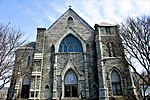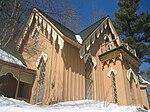Vermont College of Fine Arts
1831 establishments in VermontArt museums and galleries in VermontArt schools in VermontArts organizations established in 1831Buildings and structures in Montpelier, Vermont ... and 5 more
Education in Washington County, VermontEducational institutions established in 1831Private universities and colleges in VermontTourist attractions in Washington County, VermontVermont College of Fine Arts
Vermont College of Fine Arts (VCFA) is a private graduate-level art school in Montpelier, Vermont. It offers Master's degrees in a low-residency format. Its faculty includes Pulitzer Prize finalists, National Book Award winners, Newbery Medal honorees, Guggenheim Fellowship and Fulbright Program fellows, and Ford Foundation grant recipients. The literary magazine Hunger Mountain is operated by VCFA writing faculty and students.
Excerpt from the Wikipedia article Vermont College of Fine Arts (License: CC BY-SA 3.0, Authors).Vermont College of Fine Arts
College Street, Montpelier
Geographical coordinates (GPS) Address Nearby Places Show on map
Geographical coordinates (GPS)
| Latitude | Longitude |
|---|---|
| N 44.255277777778 ° | E -72.5675 ° |
Address
Vermont College of Fine Arts
College Street 36
05602 Montpelier
Vermont, United States
Open on Google Maps







